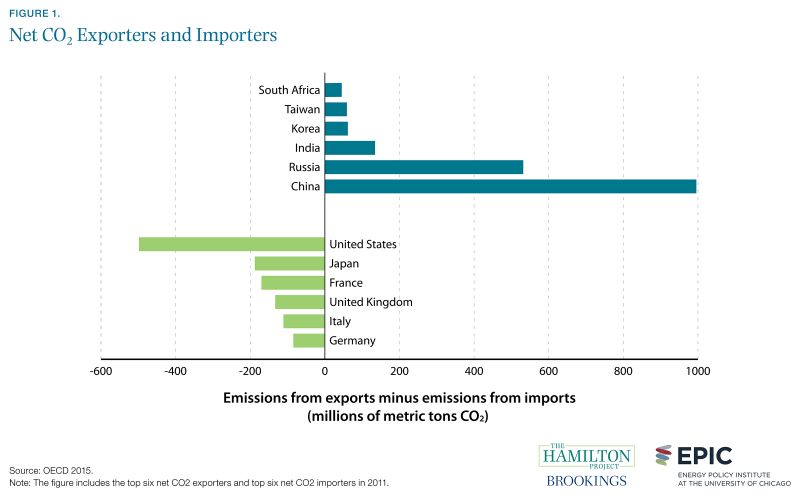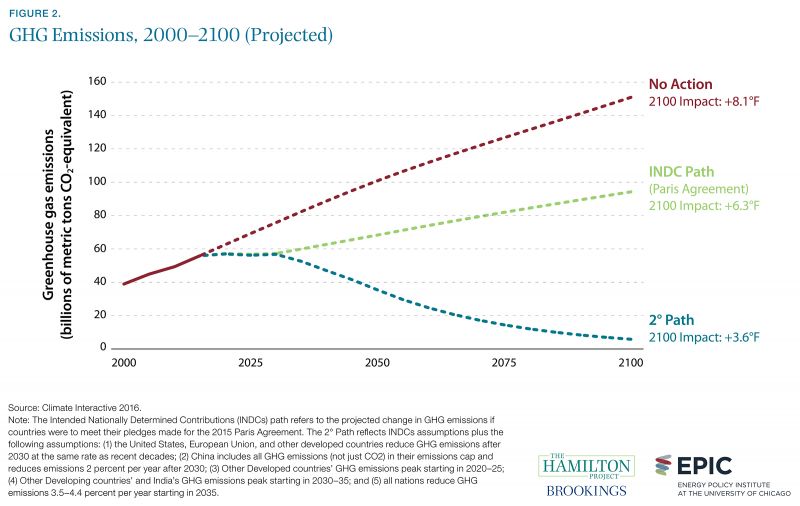Greenhouse gas (GHG) emissions—and primarily CO2 emissions—have meaningfully contributed to the warming the globe has experienced so far, and are expected to cause a damaging level of warming in coming decades. In the past, most global emissions originated in developed nations in Europe and North America. Even today, the United States emits a relatively high level of CO2 per person. However, new CO2 emissions are increasingly generated by China, India, and other developing economies. As economic and population growth surge in these countries, CO2 emissions are predicted to rise accordingly. Consequently, global emissions will continue to rise despite stabilization in Europe and the United States.
It remains uncertain whether policy makers around the world will be successful in responding to the threat of climate change. Although the U.S. has taken important steps in recent years, it is still not on pace to meet its Paris Agreement commitment of a 26 to 28 percent reduction in economy-wide emissions from 2005 levels by 2025. Furthermore, the Trump administration’s preliminary budget proposal would end both domestic and international programs that aim to mitigate GHG emissions, such as the Clean Power Plan, the Global Climate Change Initiative, and the Green Climate Fund, raising more questions about whether the U.S. will meet its commitments.
Many scientists believe sharper reductions are necessary to avoid dangerous future climate change, arguing that warming should be limited to no more than 3.6°F (2°C). Achieving that target would require much more dramatic actions than have been agreed to under the Paris pledges.
The United States is a net CO2 importer, meaning that it consumes more goods involving CO2 emissions than it produces.
CO2 emissions vary considerably by country, with some of the variation explained by the predominance of different industries and types of economic activity. Some economic sectors involve more CO2 emissions than others. For instance, a country that specializes in financial services may have relatively low CO2 emissions, whereas a country that specializes in heavy industry will generate relatively high CO2 emissions.
However, even a country that produces relatively low CO2 emissions likely consumes a wide variety of goods and services that entail CO2 emissions. Such a country would be a net CO2 importer, and its CO2 emissions profile would belie a larger underlying contribution to climate change. Conversely, a country that specializes in heavy industry would be a net CO2 exporter, with its consumers generating lower CO2 emissions than its national CO2 profile would indicate.
Figure 1 depicts the top CO2 net exporters and importers using data from the OECD. China and Russia are the largest net exporters, while the United States and Japan are the largest net importers.

National policy actions following the 2015 Paris Agreement are expected to mitigate growth in global GHG emissions.
Climate change is already underway, but policy makers can reduce the extent of the damage. As shown in figure 2 using data from Climate Interactive, if no actions are taken to mitigate GHG emissions, global average temperatures will rise by more than 8°F (4.4°C) by 2100 relative to preindustrial levels. This would occur as global GHG emissions climbed to nearly four times 2000 levels.
As part of the 2015 Paris Agreement, policy makers from many nations made commitments to reduce GHG emissions. The Intended Nationally Determined Contributions (INDCs) reflect a public agreement on post-2020 climate actions that would, if implemented, limit the increase in temperature by year 2100 to 6.3°F (3.5°C).
This level of warming remains dangerous both economically and ecologically. A more aggressive, commonly discussed GHG emissions mitigation target is the 3.6°F (2°C) warming limit. If global temperature rise is to be kept below this ceiling—which is already at the outer limits of what scientists consider to be safe—annual GHG emissions would need to fall to near zero by 2100. Existing political agreements are not sufficient to hold climate change beneath this ceiling.

A forthcoming document authored by The Hamilton Project and The Energy Policy Institute at the University of Chicago further explores a number of areas related to climate change, including energy markets, GHG emissions, and investments in climate resilience. As policy makers and businesses confront the challenge of climate change, it is important that their actions be guided by sound evidence and a full understanding of the economic and scientific context.



